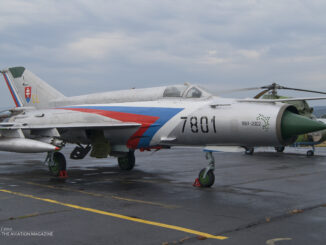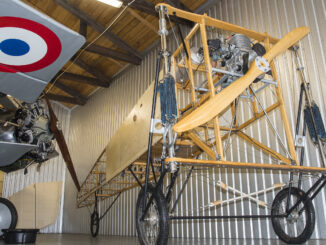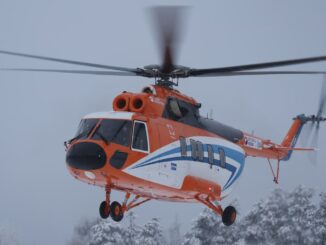 Eurocopter AS350 B3e Écureuil (c/n 7545, OK-DSW, operated by DSA a.s.), taking-off for a flying display during open doors day at Aeroklub Jaroměř airfield, Jaroměř, June 2023.
Eurocopter AS350 B3e Écureuil (c/n 7545, OK-DSW, operated by DSA a.s.), taking-off for a flying display during open doors day at Aeroklub Jaroměř airfield, Jaroměř, June 2023.
The AS350 helicopter was designed in the early 1970s by French aviation company Aérospatiale (that is why the rotorcraft has its type code ´AS350´). At the roots of the development programme was the need to create a successor for still popular but quickly ageing Alouette II.
The aforementioned programme resulted in two new rotorcraft designs. The first was Aérospatiale Gazelle, developed in the late 1960s and primarily intended for military and government-related operators. It was also the first helicopter in the world featuring a fenestron type tail rotor.
Following successful creation of the Gazelle, the development team at Aérospatiale, led by Chief Engineer René Mouille, focused on another helicopter. This time it had to be a versatile, light utility helicopter intended for civil market – therefore less sophisticated and easier on maintenance, as well as cost-effective.
The new helicopter was developed with cutting edge engineering innovations, such as ´Starflex´ main rotor head, light-alloy rolled sheet structure, as well as use of composite materials.
On 27th June 1974, the prototype of AS350B performed its maiden flight. Initially, the rotorcraft was powered by single Lycoming LTS101 turboshaft engine, howewer, yet in February of the next year, another variant designated AS350C followed, this time powered by Turbomeca Arriel 1A.
In 1978, the first serial examples of the helicopter were delivered to its first customers.
The AS350 Écureuil (English: squirrel) quickly proved to be commercial success. Until today, there were more than 7,000 examples of the rotorcraft manufactured. Apart from dozens private operators all over the world, the AS350 is also being used by governments, law enforcement agencies and emergency medical services, as well as some air forces and other military operators.
The helicopter remains in production until today, of course with many modifications and upgrades. In 1992, Aérospatiale and DASA rotorcraft division merged into Eurocopter and the new company took over the production of the AS350. Since 2014, the rotorcraft is offered by Airbus Group and now designated H125.
The AS350 was developed with special focus on low noise and high-altitude operations. Therefore, the helicopter is usually the best choice for an operator that needs to fly among the highest mountains, in wildlife and nature reserves, as well as within urban areas.
Therefore, it is no surprise the AS350 is known from several high-altitude aviation records and spectacular rescue actions, being able to save lives on the verge of rotorcraft abilities.
In 2010, Écureuil rescued alpinists from Annapurna, at the altitude of 6,900 metres. Three years later, another rescue flight was performed in Mount Everest area, saving an alpinist at the altitude of 7,800 metres. In 2014, the AS350 B3e set a national record of Mexico, successfully landing on the top of Pico de Orizaba, at 5,636 metres above the sea level.
Nevertheless, the greatest so faraviation stunt with Écureuil was performed on 14th May 2005. On that day, a modified AS350 B3e flown by Didier Delsalle touched the peak of Mount Everest, at an altitude of 8,848 metres. That achievement was officially recognized by the FAI as world record in helicopter aviation category.
The rotorcraft pictured within our Photo of the Week series is exactly the same high-performance variant known from the abovementioned record flight. That B3e version was introduced in late 2011 and is powered by Arriel 2B engine, generating 848 hp.
The AS350 B3e OK-DSW was manufactured in 2012 and then acquired by Czech aviation company DSA a.s., becoming the first helicopter of that type in the Czech Republic.



